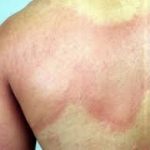 Immediate hypersensitivity response to antigenic challenge, mediated by IgE and mast cells; typically life‐threatening.
Immediate hypersensitivity response to antigenic challenge, mediated by IgE and mast cells; typically life‐threatening.
A severe, life-threatening allergic response that may be characterized by symptoms such as reduced blood pressure, wheezing, vomiting or diarrhea.
Hypersensitivity resulting from sensitisation following prior contact with the causative agent.
Life-threatening systemic allergic reaction.
Allergic reaction of the body to a foreign body or other substance. Sometimes used to refer exclusively to a sudden, unusually severe, and possibly life-threatening allergic reaction.
A severe systemic allergic response characterized by redness, itching, swelling, and water buildup (angioedema); in severe cases, life-threatening respiratory distress occurs and the blood pressure drops rapidly (anaphylactic shock).
An allergic reaction, usually to certain insect stings, vaccinations prepared with egg products, or certain foods or drugs that often cause hives, itching, angioedema, and sometimes airway obstruction as well as a marked decrease in blood pressure, which may lead to death.
An exaggerated reaction to a foreign substance.
Extreme sensitivity to a substance introduced into the body.
A sudden, severe, life-threatening allergic reaction that can cause airways to narrow and breathing to become blocked. Other symptoms may include hives, itching, swelling, vomiting, diarrhea, and a drop in blood pressure.
Severe immune response that, if untreated, leads to coma and death. The response is due to a massive release of histamine that causes blood vessels to dilate and blood pressure to fall.
Rapidly developing, very pronounced hypersensitivity reaction following the injection of a second dose of foreign protein (serum) into an animal or man within a few days of the primary sensitizing dose. Anaphylaxis is discussed further under ‘Hypersensitivity’.
Strong hypersensitivity reaction to the ingestion or injection of a substance (e.g., penicillin, shell¬ fish) to which the organism has become sensitized by a previous exposure. Symptoms may include localized wheal, itching and swelling, or, in severe cases, anaphylactic shock and even death.
Extreme, immediate, hypersensitive reaction to an antigen, protein, or drug with systemic effects including bronchospasm, peripheral edema, and laryngeal edema; these effects may be life threatening.
An extreme allergic state that may be fatal if not immediately treated effectively.
A severe, potentially life-threatening allergic reaction that is characterized by swelling of the throat, difficulty breathing, and a sudden fall in blood pressure. Anaphylaxis, which is also called anaphylactic shock, is an infrequent but very serious allergic reaction and an example of immediate hypersensitivity. It usually occurs within seconds or minutes of exposure to minute amounts of an allergen (allergy-causing substance) to which a person is highly sensitized. The body’s immune response to the allergen involves the release of histamine and other body chemicals. These immune chemicals produce hives, swelling of the skin, and severe breathing problems caused by swelling tissues in the throat and a narrowing of the airways. The blood vessels swell and become wider, which results in a dramatic drop in blood pressure. These symptoms are a medical emergency, and immediate medical attention can be lifesaving.
An abnormal reaction to a particular antigen, in which histamine is released from tissues and causes either local or widespread symptoms. An allergic attack is an example of localized anaphylaxis. Rarer, but much more serious, is anaphylactic shock: an extreme and generalized allergic reaction in which widespread histamine release causes swelling (edema), constriction of the bronchioles, heart failure, circulatory collapse, and sometimes death.
An immediate (and potentially health- or life threatening) allergic reaction produced by the body’s immunoglobulin E (IgE) antibodies to a foreign substance (antigen); the affected tissues release histamine which causes local or systemic _attack. An example is the pain, swelling, eruption, fever and sometimes collapse that may occur after a wasp sting or ingestion of peanut in a particularly sensitive person. Some people may suffer from anaphylaxis as a result of allergy to other foods or substances such as animal hair or plant leaves. On rare occasions a person may be so sensitive that anaphylaxis may lead to profound shock and collapse which, unless the affected person receives urgent medical attention, including injection of adrenaline, may cause death.
A type I hypersensitivity (allergic) reaction between an allergenic antigen and immunoglobulin E (IgE) bound to mast cells, which stimulates the sudden release of immunological mediators locally or throughout the body. The first symptoms occur within minutes, and a recurrence may follow hours later (late-stage response). Anaphylaxis can only occur in a person previously sensitized to an allergen because the initial exposure causes immunoglobulin E (IgE) to bind to mast cells. Anaphylaxis may be local or systemic. Local anaphylactic reactions include hay fever, hives, and allergic gastroenteritis. Systemic anaphylaxis produces peripheral vasodilation, bronchospasm, and laryngeal edema and can be life-threatening.
An intense allergic reaction that results in a sudden decline in blood pressure, an accelerated heartbeat, inflammation of the airway, the appearance of a rash, and the potential occurrence of convulsions.
Anaphylactic shock is a severe, life-threatening reaction that can occur after a second exposure to a specific substance, often a soluble protein, to which the individual was previously sensitized. The initial exposure typically occurs 10 to 12 days before the second one, although the timing can vary. This reaction can happen even weeks or months after the first dose. For example, a person highly sensitive to bee stings may experience no reaction to a first sting but could go into severe anaphylactic shock upon a second sting. The symptoms include tissue swelling that can be particularly dangerous if it occurs in the throat, causing choking. Immediate treatment usually involves an adrenaline injection. People who are highly susceptible may need to undergo desensitization through incremental doses of the allergen, like bee venom, over time. Medical professionals are cautious of this when administering second doses of substances like sera, which is why patients are sometimes asked to remain under observation for 15 to 20 minutes post-injection to manage any potential onset of anaphylactic shock with prompt adrenaline treatment.
